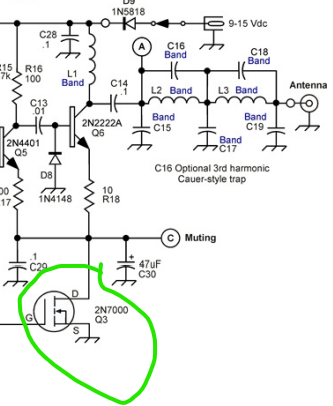KO6BTY took over debug implementation last night. She wired the RF out from the Rockmite directly to Project TouCans antenna out and... Nothing.
Looking at the schematic, that leaves a few choices for what's going on.
My favorite for the moment, because it's easy, and because the part is actually very bent, is the T/R switch transistor:
The transistor is a 2N7000 MOSFET. Wikipedia lists its maximum current as 200 mA and I can see where we could have exceed that when the Rockmite was shaking loose in TouCans (several of the nylon spacers sheered after a fall.) Also, keep in mind that the power bump has more current traveling through this part of the circuit in any event.
After that, we'll be looking at whether or not the oscillator is still oscillating. But actually! Good news! If the oscillator weren't oscillating, the receive branch also wouldn't work, and it most certainly is working!


Comments
Post a Comment
Please leave your comments on this topic: